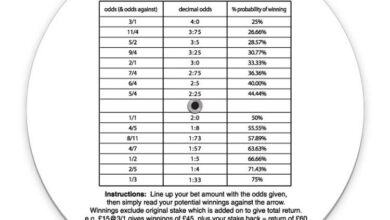How to read soccer betting odds
In the vibrant world of soccer, where passion unfolds on the pitch and every match brings a wave of anticipation, another game is being played beyond the field: the art of betting. For the uninitiated, navigating the intricate web of soccer betting odds can feel akin to decoding a foreign language. Yet, understanding these odds is not merely a skill for seasoned gamblers; it’s an empowering tool for any soccer enthusiast eager to enhance their viewing experience. In this article, we will demystify the various types of soccer betting odds, offering you a clear guide to interpreting them with confidence and precision. Whether you’re a casual fan looking to engage more deeply with the sport or a budding bettor aiming to make informed decisions, our exploration will illuminate the path to smarter betting strategies and a richer appreciation of the beautiful game.
Table of Contents
- Understanding the Basics of Soccer Betting Odds
- Deciphering Fractional, Decimal, and Moneyline Odds
- Analyzing Probabilities Behind the Numbers
- Strategies for Making Informed Betting Decisions
- Q&A
- Insights and Conclusions
Understanding the Basics of Soccer Betting Odds
Grasping the fundamentals of soccer betting odds is essential for anyone looking to place informed bets. At its core, betting odds represent the likelihood of an event occurring, as well as the potential return on your investment. Odds can generally be presented in three formats: fractional, decimal, and moneyline. Understanding each of these formats will help you make more strategic decisions when betting on soccer matches. For example, fractional odds (e.g., 5/1) indicate that for every 1 unit you wager, you could win 5 units, while decimal odds (e.g., 6.0) encompass both your stake and profit, denoting a total payout of 6 times your initial wager.
In addition to knowing the odds formats, it’s important to familiarize yourself with various betting terms that are frequently used in soccer betting. Here are some key concepts to keep in mind:
- Stake: The amount of money you place on a bet.
- Profit: The money earned from a winning wager, exclusive of the stake.
- Over/Under: A bet on whether the total goals scored in a match will be over or under a specified number.
- Match Result: A bet on the outcome of the game, including win, lose, or draw.
Each of these terms plays a significant role in helping you navigate your betting experience more effectively. By analyzing odds and comprehending key terms, you can increase your chances of making successful bets. For those wanting a deeper understanding and real-time insights into soccer betting, explore resources like BetReward.
Deciphering Fractional, Decimal, and Moneyline Odds
Understanding the different formats of betting odds can significantly enhance your betting experience. Fractional odds, commonly used in the UK, are expressed as a fraction such as 5/1 (read as “five to one”). This indicates that for every $1 you wager, you stand to win $5 if your selection is successful. To calculate your total return, simply multiply your stake by the first number in the fraction and add your original stake. For example, if you bet $10 on odds of 5/1, you’ll receive $50 in winnings plus your $10 stake for a total of $60. Key points about fractional odds:
- Easy to calculate: Simply multiply your stake by the numerator.
- Common in horse racing: This format is prevalent in British sports betting.
- Intuitive understanding: The fraction directly shows potential profit versus stake.
On the other hand, decimal odds, which are popular in Europe and Canada, express odds in a single figure, for example, 6.00. This number includes the stake in addition to the winnings. To find out how much you’ll earn, multiply your stake by the decimal odds. So, a $10 bet at 6.00 would yield $60—$50 in profits plus your original stake. Moneyline odds, primarily used in North America, can be a bit trickier. They appear as either a positive or negative number: +500 means you would win $500 on a $100 bet, while -200 means you must wager $200 to win $100. Here’s a breakdown of these odds formats:
| Odds Format | Example | Profit Calculation |
|---|---|---|
| Fractional | 5/1 | Wager $10, Win $50 + Stake = $60 |
| Decimal | 6.00 | Wager $10, Win $50 + Stake = $60 |
| Moneyline (+) | +500 | Wager $100, Win $500 |
| Moneyline (-) | -200 | Wager $200, Win $100 |
For more information and resources on understanding soccer betting odds, visit BetReward.
Analyzing Probabilities Behind the Numbers
Understanding soccer betting odds requires a keen eye for the probabilities they represent. Odds communicate not just the potential payout for a bet but also the implied likelihood of an event occurring. For instance, odds of 2.00 suggest that the bookmaker sees a probability of 50% for that outcome. However, it’s crucial to note that these odds are often adjusted for the bookmaker’s margin, which means the actual probability may be slightly different. When analyzing odds, consider the following factors to gain deeper insights:
- Market Trends: Observe how the odds shift as the match date approaches, which can indicate where money is being placed.
- Team Form: Look at recent performances, injuries, and head-to-head statistics to assess actual probabilities.
- Public Sentiment: Understand how public opinion may skew odds, as sportsbooks adjust in response to popular betting.
To visualize how these probabilities work, consider a simplified odds table that demonstrates various outcomes and their implied chances:
| Outcome | Odds | Implied Probability (%) |
|---|---|---|
| Home Win | 1.80 | 55.56 |
| Draw | 3.40 | 29.41 |
| Away Win | 4.50 | 22.22 |
This table illustrates that while the home team may be favored, understanding the interplay of odds and actual probabilities can uncover potential value. Utilizing resources like BetReward can further enhance your approach to analyzing soccer odds and making informed betting decisions.
Strategies for Making Informed Betting Decisions
Making informed betting decisions begins with understanding the odds and the factors that influence them. It’s essential to research team statistics, including previous performance, player injuries, and head-to-head records. By keeping track of recent form, you can gauge the likelihood of each team’s success. Furthermore, consider external factors such as weather conditions or match location that might affect gameplay. A well-rounded analysis not only enhances your betting strategy but also increases your chances of success.
Additionally, employing a solid money management strategy can greatly impact the sustainability of your betting experience. Set a budget and determine the size of your bets based on that budget. It’s advisable to focus on value betting, where you identify odds that offer a better payout than the actual probability of an outcome occurring. This can be effectively tracked using a simple table to compare odds at various sportsbooks:
| Bookmaker | Team A Odds | Team B Odds |
|---|---|---|
| BettingSite1 | 2.00 | 1.80 |
| BettingSite2 | 1.95 | 1.85 |
| BetReward | 2.10 | 1.75 |
This table showcases how odds can differ across platforms, allowing you to spot the best options for your bets. By combining thorough research with strategic money management, you can significantly increase your potential for making profitable decisions in the thrilling world of soccer betting.
Q&A
Q&A: How to Read Soccer Betting Odds
Q1: What do soccer betting odds represent?
A1: Soccer betting odds essentially represent the bookmaker’s assessment of the likelihood of a particular outcome occurring in a match. They reflect the probability of a team winning, losing, or drawing, and they also determine how much you can win if your bet is successful. Odds can seem like a complex matrix, but they are rooted in basic arithmetic and probabilities.
Q2: How are soccer betting odds formatted?
A2: Soccer betting odds come in three main formats: fractional (UK), decimal (European), and American (moneyline). Fractional odds, such as 5/1, indicate that for every $1 bet, you could win $5. Decimal odds simplify this by showing the total return on a $1 bet, such as 6.0, meaning you’d receive $6 back for every dollar wagered, inclusive of your initial stake. American odds might appear as +500 for a bet on an underdog, indicating you would win $500 on a $100 bet, while negative odds, like -200, show how much you need to bet to win $100.
Q3: How do I interpret odds when betting on a favorite vs. an underdog?
A3: Odds can offer immediate insight into team strengths. A favorite typically has lower odds (e.g., 1.50), indicating a higher probability of winning, but a smaller payout. Conversely, an underdog will have higher odds (e.g., 4.00), suggesting a lower chance of victory, but the potential for a larger payout if they pull off the upset. Thus, the choice between favorites and underdogs often weighs risk against potential reward.
Q4: What do implied probabilities indicate about the odds?
A4: Implied probability transforms odds into a percentage format, representing the bookmaker’s estimation of an outcome’s likelihood. For instance, with decimal odds of 2.00, the implied probability is 50% (1 divided by the odds). This means that, according to the odds, the outcome is expected to happen 50 times in 100 attempts. This concept can help bettors assess value: if you believe the actual likelihood of an event is greater than the implied probability, then it might be a good bet.
Q5: Why do odds change leading up to a match?
A5: Odds fluctuate due to various factors, including team performance, player injuries, weather conditions, and betting volume. As more bettors place money on certain outcomes, bookmakers adjust the odds to balance their risk and ensure profitability. This dynamic nature of odds means timing your bets can be crucial; you might score better odds before a heavy influx of bets swings them in favor of one team.
Q6: Can I bet on outcomes besides just winning or losing?
A6: Absolutely! Soccer betting encompasses a range of options beyond simply choosing a winner. You can bet on the total number of goals scored (over/under), specific player performances (first goal scorer, anytime goal scorer), match results (including draws), and even statistical outcomes like corners or cards. Each of these has its own set of odds, offering unique opportunities for savvy bettors.
Q7: What is the role of bookies in setting the odds?
A7: Bookmakers, or bookies, set the odds based on a combination of statistical models, expert opinions, and public sentiment. They aim to create a balanced book where money is evenly placed on both sides of a bet, allowing them to profit from the vig (the bookmaker’s margin) regardless of the outcome. Understanding their perspective on odds can give you insights into potential betting strategies.
By understanding these fundamentals of soccer betting odds, players can navigate the world of sports betting with greater confidence and make more informed decisions.
Insights and Conclusions
As we wrap up our exploration of soccer betting odds, it’s clear that understanding these numerical indicators can transform your betting experience from a game of chance into a more informed decision-making process. Whether you’re a seasoned punter or a curious newcomer, the insights gained from reading odds not only enhance your engagement with the matches but also empower you to make strategic bets.
Remember, odds are not just figures; they tell a story—reflecting team form, player conditions, and the many variables swirling around the beautiful game. As you step into the exciting world of soccer betting, keep your focus sharp, your analysis thorough, and your expectations realistic.
So, lace up your boots and embrace the thrill of the pitch armed with newfound knowledge. Happy betting, and may your selections be as sharp as a last-minute goal!





